- How can my pet celebrate the holidays, with their nutrition needs in mind?
- How can I prepare my pet for holiday travels?
- How can I protect my pet from holiday plants and decorations?
- How do I choose the purrr-fect gift for my pet?
- How can I create a pet-safe environment for holiday gatherings?
- How can I support animal causes during the season of giving?
For many, our pets are the heart and soul of the holiday season. But even the most wonderful time of the year could pose threats to your fur fam.
Picture this: Your curious cat, Mr. Whiskers, slyly nabbing a sprig of mistletoe. Before you know it, Mr. Whiskers is feeling under the weather, leading to an unexpected and costly trip to the vet during the holiday rush. That’s where pet insurance can come in handy.
Let’s get into the nitty gritty of how you can make winter festivities joyful and safe for your furry family members.
How can my pet celebrate the holidays, with their nutrition needs in mind?
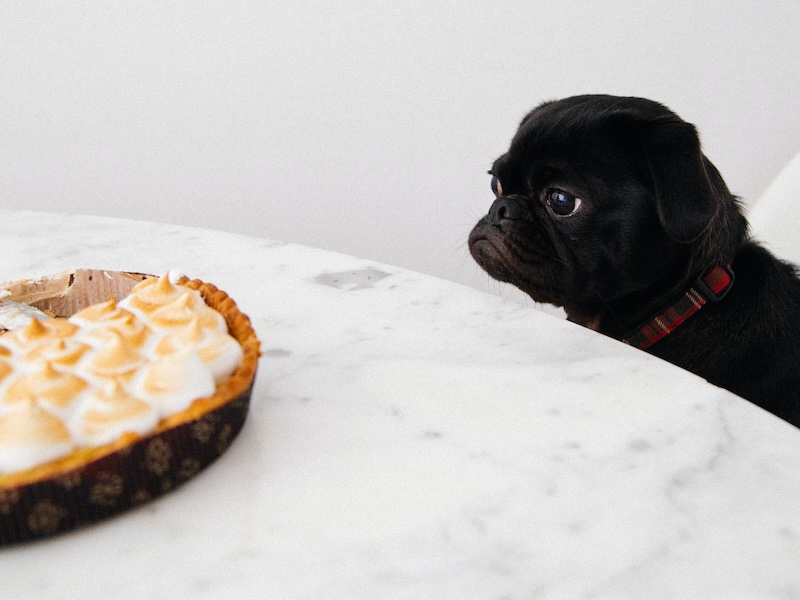
The holiday season is all about spending time with loved ones and enjoying special meals together. As the humans dig into their favorite dishes, your furry friend might be left wondering: What about me?
It can be tough to navigate safe food options for your pup during the hustle and bustle of a holiday meal.
Keep your dog’s paws off these holiday foods
It’s always important to have an eye on what your pup is eating—but even more so during holiday gatherings, when a bunch of tempting (but dangerous) foods are within reach.
Click below for a cheat sheet of festive foods that are dog-safe, as well as dangerous treats to keep out of reach during the holiday season.
Chocolate
Common in holiday treats and desserts, chocolate—especially dark or baking chocolate—is toxic to dogs.
Grapes and raisins
Often found in fruitcakes or other desserts, these ingredients can cause kidney failure in dogs.
Onions, garlic, and leeks
Can lead to anemia by damaging a dog’s red blood cells.
Mushrooms
While not all mushrooms are toxic, some types can be poisonous and lead to serious health issues.
Bones
These can splinter and become hazardous; bones from dishes like turkey or chicken are especially risky.
Ham, turkey skin, and gravy
Rich in fats, which can lead to pancreatitis in dogs, which can be acute and sometimes occur from just one serving of these foods.
Nutmeg
Used in dishes like pumpkin pie and some holiday drinks (like pumpkin spice lattes), it can cause seizures and central nervous system issues in dogs.
Salt
Monitor how many salty foods your pup is scarfing. In large amounts, salt can cause excessive thirst and urination, and even sodium ion poisoning (aka Salt Toxicosis).
Alcohol
Even sneaking a couple sips from the makeshift bar at a holiday party can intoxicate pets, leading to vomiting, decreased coordination, and more severe symptoms.
If you ever suspect your dog has ingested something toxic, consult a veterinarian immediately or call the ASPCA Animal Poison Control Center: (888) 426-4435.
For the toxic food completists out there, check out this comprehensive chart that lays out the symptoms your dog might experience if they gobble down something they shouldn’t, and how much a trip to the vet could cost to treat them.
Vet-approved holiday recipes
Try your hand at these seasonal novelties that your pooch can safely enjoy.
Keep in mind: While these recipes include ingredients that are safe for most dogs, some pets may have specific dietary needs or sensitivities. Always introduce new foods in moderation and keep an eye out for any adverse reactions.
How can I prepare my pet for holiday travels?
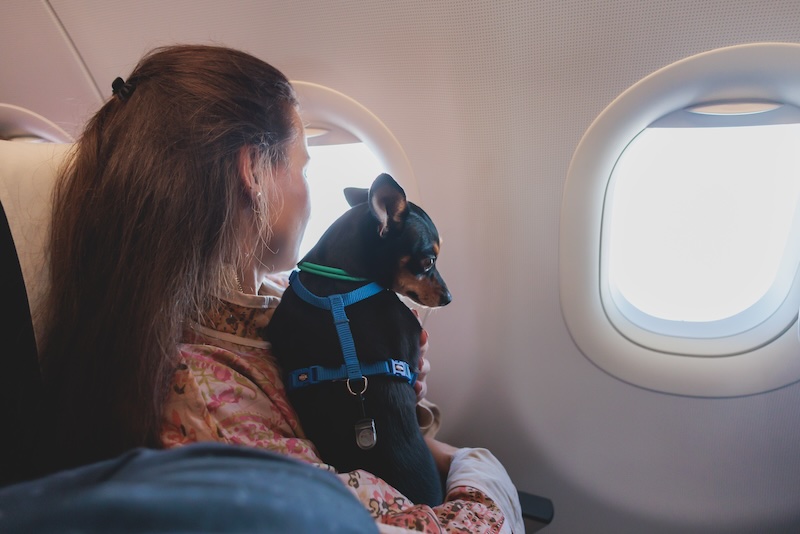
It can be tough to decide what to do with your pet over the holidays. Fly? Take an adorable roadtrip with your favorite backseat driver? Or leave your furry friend back home with a trusted pet boarding facility?
There are several factors to weigh for each option. Talk to your vet well in advance of your travel plans about potential solutions or medications to help your fur fam stay safe and comfortable during holiday travel.
Flying with your pet
Pros
- Pet accompanies you to destination
- Faster travel time, compared to a long road trip
- Some airlines offer pet-friendly amenities—for example Alaska Airlines charges $100 per pet carrier each way in the main cabin, allows two pets per carrier, and also permits pets to fly in the climate-controlled baggage compartment
Cons
- Exposure to potentially stressful environments and noises, especially if in cargo
- Additional headache in booking flights, and preparing required documents and materials
- Airlines charge roughly $95 to $125 each way per pet that travels in the main cabin, and they’ll likely need to fit under the seat
Driving with your pet
Pros
- More control over breaks and stops, compared to flying
- Familiar environment in car, but make sure to acclimate your dog to car travel first
- Flexible schedule
Cons
- Longer travel time than flying
- Requires more planning for pet-friendly pit stops—like these travel centers that have dog parks on-site
- Pet can be a driving distraction, always use a crash-test certified dog car safety restraint
Traveling without your pet
Pros
- Pet could stay in a familiar environment, which might lead to the least amount of stress on them
- Peace of mind with trusted care
Cons
- Could lead to separation anxiety, for both you and your pet
- Pet might not stay on their usual routine, depending on the pet care
- Pet care services can get pricey—for example overnight dog boarding can start around $50 a night, and go up to more than $100 per dog per night.
Head to our travel safety guide for pet parents for additional resources on prepping your pet for a flight or long drive—which should start several months before your trip—plus an analysis of pet care options if you’re traveling without them.
How can I protect my pet from holiday plants and decorations?
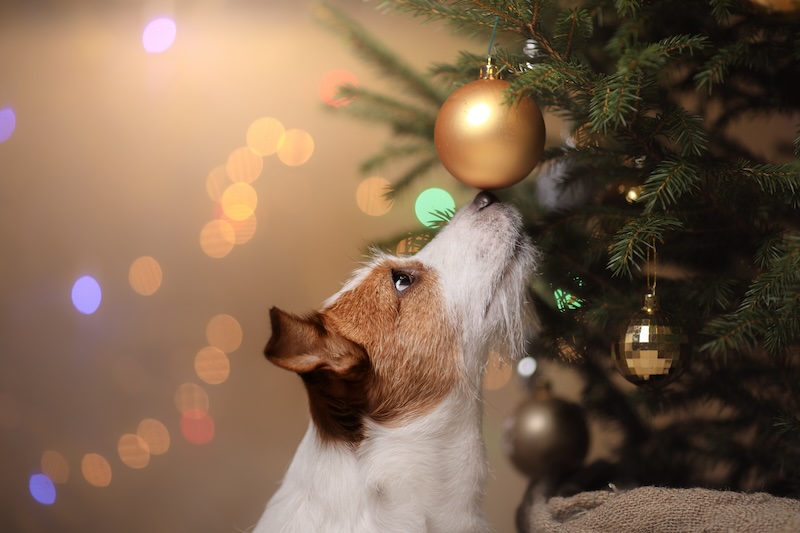
Our homes often glow with beautiful decorations during the festive season (sometimes even before Halloween, but this is a judgment-free zone).
To your pet, holiday decor can look like a toy or a tasty treat, but they can pose serious—and pricey—threats such as choking and intestinal blockage.
Here’s a list of common holiday adornments that can be hazards to dogs:
- Tinsel. Easily ingested and can lead to intestinal blockages.
- Pine needles. Can puncture or irritate the intestines if ingested.
- Ornaments. Can shatter and cause cuts or, if consumed, internal damage.
- Holiday lights. Can cause electrical shock if chewed on.
- Menorah candles and Kwanzaa kinara. Burn risk if knocked over or if the dog comes too close, and ingested candles are a choking hazard.
- Dreidel. Small parts can be a choking hazard or cause intestinal blockages if swallowed.
- Gift wrap ribbons and bows. Can cause intestinal blockages if ingested.
- Christmas trees. Natural oils can be irritating to the mouth and stomach, causing drooling or vomiting, and the water they sit in can contain bacteria or chemicals.
- Dried ears of corn. Choking hazard and potential for intestinal blockage.
- Poinsettias. Mildly toxic, can cause mouth and stomach irritation and occasional vomiting.
- Holly and mistletoe. Toxic and can cause nausea, diarrhea, and other symptoms.
Keep potentially harmful decorations out of your pet’s reach and always supervise them around festive displays.
If you’re putting up a Christmas tree, secure it to prevent it from being knocked over, and use protective barriers or baby gates to keep your pup away from where pine needles may fall.
How do I choose the purrr-fect gift for my pet?

When your pet says they don’t want any presents this holiday season, you know they don’t really mean it.
But how can you choose a gift for your pet that lets them know they’re the good-est boy or girl in the world? Here are some factors to consider when shopping for your furry companion.
Safety
Prioritize non-toxic materials, and avoid small parts—like toys with squeakers, or clothes with buttons—that could be ingested. Keep in mind: Large toys can be just as dangerous if pieces can easily be bit off and eaten.
For pets that are heavy chewers, opt for more robust, durable toys. Even for the most gentle of players, look for heavy duty toys, like The Virtually Indestructible Ball.
Interactive vs. solo play
Decide whether you want toys to engage with your pet, or ones they can use independently. For instance, if your Blue Heeler is hinting that they expect a tug-of-war toy, but you don’t want to be caught on the other end of the match, consider a design that’s meant for independent play, like the XiaZ Tug Toy.
Enrichment
Toys that stimulate the mind—like puzzle feeders—can offer pets several benefits, including:
- Mental stimulation, keeping them sharp and engaged
- Reduce boredom, especially for pets that spend a lot of time indoors
- Physical activity, as puzzles often require pets to move, paw, nudge, or lick
- Lower stress and anxiety levels—especially for pet who struggle with separation anxiety—by diverting their attention from potentially stressful stimuli
- Slow down pets that tend to eat quickly
- Deter pets from destructive behaviors—like chewing on the furniture
Your pup might even enjoy a dog-friendly game of hide-and-seek with the Frisco Flying Saucer & Aliens Hide & Seek Puzzle Plush Squeaky Dog Toy.
Practicality
Think of gifts that can also serve a purpose—like a new collar, portable water bowl, or winter coat. Sure a pair of doggles might just look like a fashion statement, but the right pair could also safeguard your pup’s eyes from UV rays, dust, and debris (win-win).
Personalization
Consider items that can be personalized, adding a unique touch for your pet. You could even pay homage to your pet with a little personalized gift of your own—like a custom pet portrait bag by Susan Alexandra.
Looking for more gift inspo? Check out our pet gift guide, which includes carefully curated ideas like Meowijuana for your hipster cat, and matching sweater sets for the whole fur fam. Full disclosure: We aren’t partnered or sponsored by these brands, we just think they’re awesome.
How can I create a pet-safe environment for holiday gatherings?
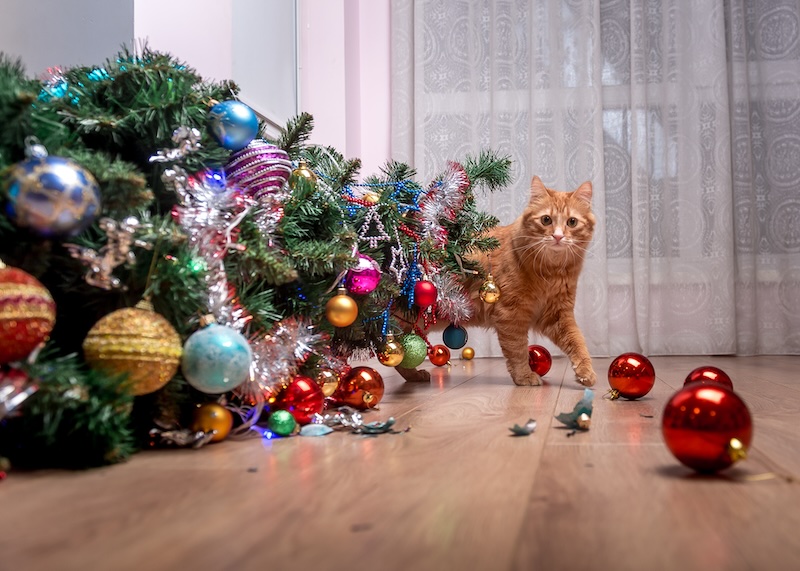
Hosting a holiday get together? Follow these tips to make sure your furry roommates still feel at home:
- Spend a few days before the party revisiting basic commands and practicing behaviors with your dog—like “stay” and “leave it”—to ensure your pet is well-behaved around guests.
- Let your guests know in advance about your pets, and set ground rules about not feeding them anything without your permission.
- If possible, designate a quiet room for your pet with their essentials—like water, toys, and their bed—plus white noise or soft music, so they have a safe space away from the bustle (especially if it’s a New Year’s celebration with fireworks).
- If your pet is social and wants to interact with guests, make introductions slowly and make sure all food, drinks, and decorations are out of reach.
- Always secure exits around your home to ensure your fur fam doesn’t make a break for it when guests come in and out.
- Monitor your pet for signs of stress and anxiety such as excessive panting, drooling, hiding, or aggressive behavior.
How can I support animal causes during the season of giving?
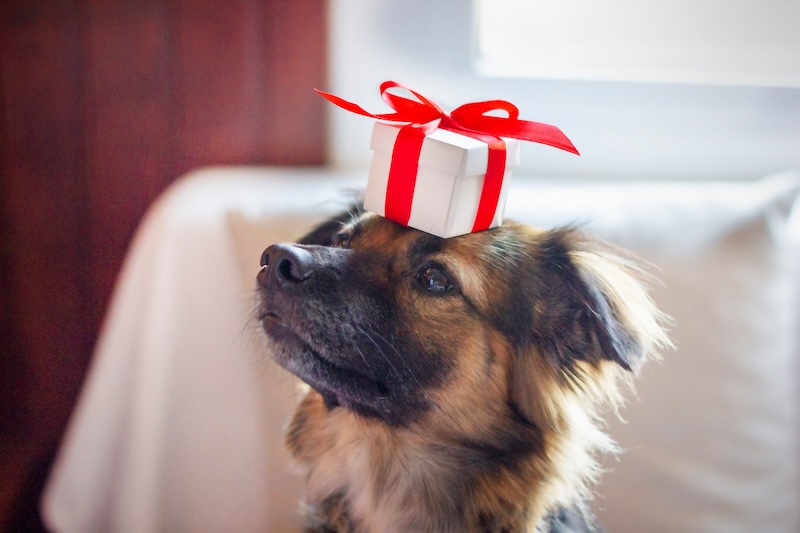
This giving season is your chance to spread your love of animals—Giving Tuesday, remember, is the first Tuesday after Thanksgiving. There are so many ways big and small to get involved—whether you volunteer at a shelter, foster a fur baby, or share animal rights petitions on social media.
Want to really make a difference for our four-legged pals? Check out the Lemonade Giveback Guide for Animal Lovers.
Before you go…
Even with every precaution, mishaps can occur during the holiday season. Having pet insurance for your fur fam can help protect your pet—and your wallet—from unexpected accidents and illnesses.
Click below to get your free Lemonade Pet quote.
A few quick words, because we <3 our lawyers: This post is general in nature, and any statement in it doesn’t alter the terms, conditions, exclusions, or limitations of policies issued by Lemonade, which differ according to your state of residence. You’re encouraged to discuss your specific circumstances with your own professional advisors. The purpose of this post is merely to provide you with info and insights you can use to make such discussions more productive! Naturally, all comments by, or references to, third parties represent their own views, and Lemonade assumes no responsibility for them. Coverage and discounts may not be available in all states.




